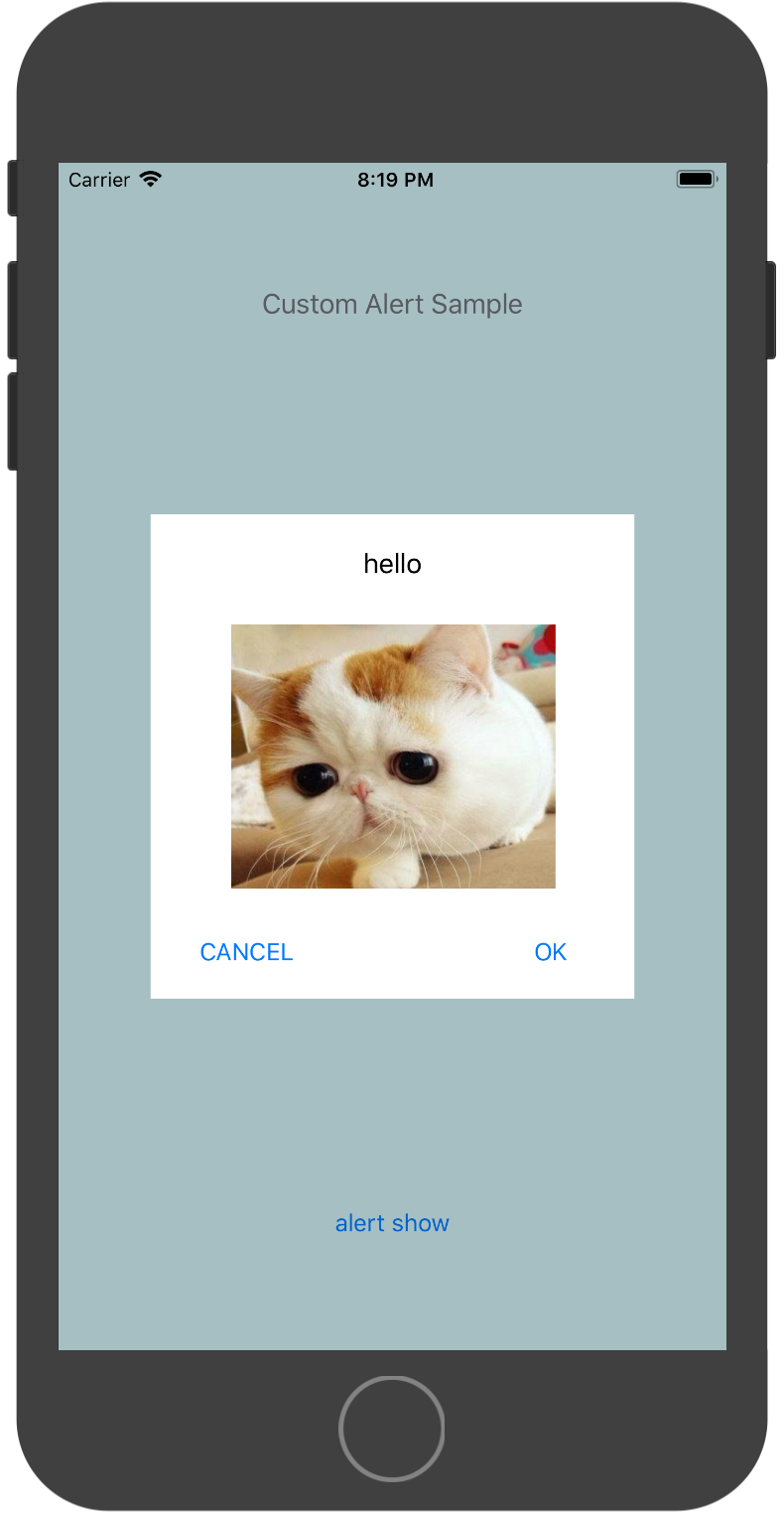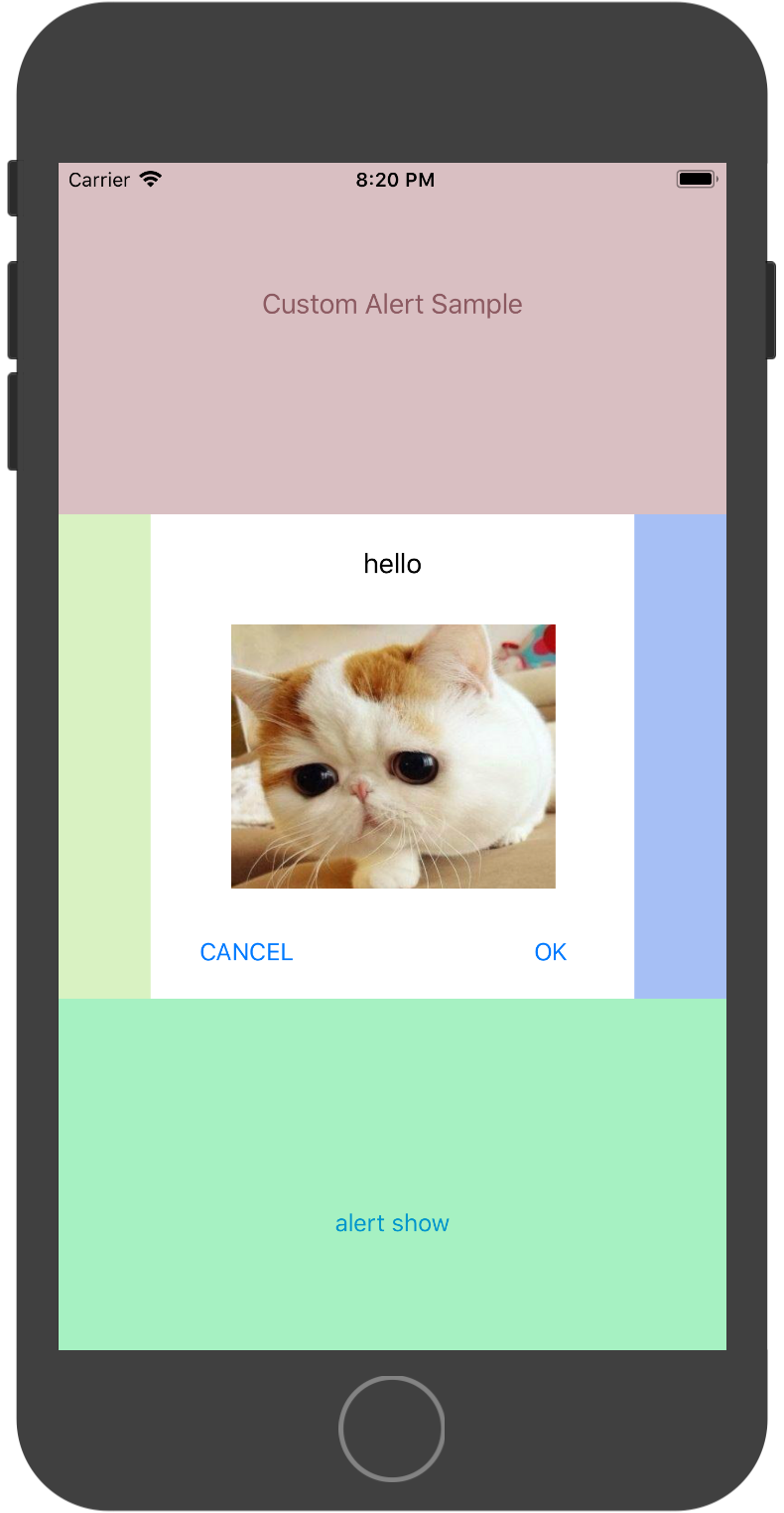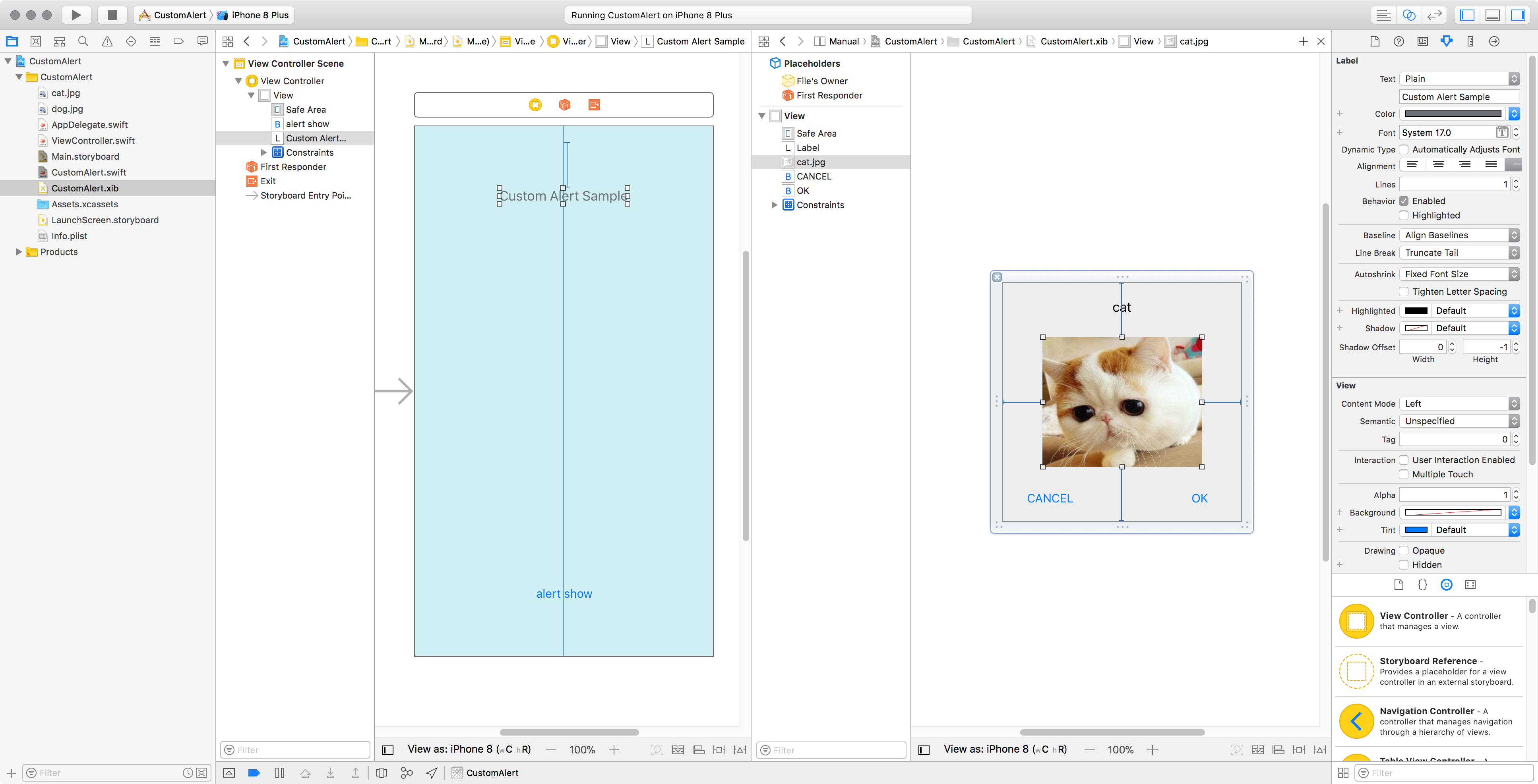Sample
アラートをポップアップさせたところ。CANCELをタップするか、余白をタップすることでアラートを閉じます。

余白タップの判定方法
下図は余白エリアの背景色に色を設定したもの。アラートViewの座標(CGPoint)と縦横サイズ(CGSize)が定まれば、余白エリアを4つの矩形としてハンドルすることができます。それぞれのエリアにUITapGestureRecognizerを用いてタップイベントにViewを剥がす処理をあてがいます。

アラートViewの作成
アラートViewはInterfaceBuilderを用いて編集しています。 File's OwnerをCustomAlertに設定します。

カスタムアラートクラス
CustomAlert.swift
import UIKit
// OKクリック処理のデリゲート
protocol CustomAlertDelegate {
func okTapped(_ alert:CustomAlert)
}
class CustomAlert: UIView {
var customAlert:UIView!
var parentView:UIView!
var topView:UIView!
var underView:UIView!
var leftView:UIView!
var rightView:UIView!
var aroundOpacity:Float = 0.2
var delegate:CustomAlertDelegate?
@IBOutlet weak var label: UILabel!
@IBAction func cannel(_ sender:UIButton) {
self.dism()
}
// OKクリック後の処理内容はコール元で定義する
@IBAction func ok(_ sender:UIButton) {
delegate?.okTapped(self)
}
required init?(coder aDecoder: NSCoder) {
super.init(coder: aDecoder)
}
// from Xib
override init(frame: CGRect) {
super.init(frame: frame)
}
func prepare(frame: CGRect, bgColor: UIColor,aroundOpacity:Float = 0.2) {
customAlert = Bundle.main.loadNibNamed("CustomAlert", owner: self, options: nil)?.first as! UIView
self.label.text = "cat"
customAlert.backgroundColor = bgColor
customAlert.layer.shadowOffset = CGSize(width:5,height:5)
let app = UIApplication.shared.delegate as! AppDelegate
parentView = app.window?.rootViewController?.view
customAlert.center = parentView.center
}
func open(aroundAreaTappable:Bool = true) {
self.label.text = "hello"
// アラートView
parentView?.addSubview(customAlert)
// 上部余白エリア
let topViewFrame = CGRect(x:0,y:0,width:(UIScreen.main.bounds.size.width),height:(customAlert.frame.origin.y))
topView = UIView(frame:topViewFrame)
topView.backgroundColor = UIColor.black
topView.layer.opacity = aroundOpacity
let tapGesTop:UITapGestureRecognizer = UITapGestureRecognizer(target: self, action: #selector(CustomAlert.dism))
if aroundAreaTappable { topView.addGestureRecognizer(tapGesTop) }
parentView?.addSubview(topView)
// 下部余白エリア
let underViewPos = CGPoint(x:0,y:(topView.frame.height + customAlert.frame.height))
let underViewSize = CGSize(width:UIScreen.main.bounds.size.width,height:topView.frame.height)
let underViewFrame = CGRect(origin: underViewPos, size: underViewSize)
underView = UIView(frame:underViewFrame)
underView.backgroundColor = UIColor.black
underView.layer.opacity = aroundOpacity
let tapGesUnder = UITapGestureRecognizer(target: self, action: #selector(CustomAlert.dism))
if aroundAreaTappable { underView.addGestureRecognizer(tapGesUnder) }
parentView?.addSubview(underView)
// 左余白エリア
let leftViewPos = CGPoint(x:0,y:(topView.frame.height))
let leftViewSize = CGSize(width:(UIScreen.main.bounds.size.width/2)-(customAlert.frame.width/2) , height:customAlert.frame.height)
let leftViewFrame = CGRect(origin:leftViewPos,size:leftViewSize)
leftView = UIView(frame:leftViewFrame)
leftView.backgroundColor = UIColor.black
leftView.layer.opacity = aroundOpacity
let tapGesLeft:UITapGestureRecognizer = UITapGestureRecognizer(target: self, action: #selector(CustomAlert.dism))
if aroundAreaTappable { leftView.addGestureRecognizer(tapGesLeft) }
parentView?.addSubview(leftView)
// 右余白エリア
let rightViewPos = CGPoint(x:(leftView.frame.width + customAlert.frame.width) , y:topView.frame.height)
let rightViewSize = CGSize(width:leftView.frame.width,height:leftView.frame.height)
let rightViewFrame = CGRect(origin:rightViewPos,size:rightViewSize)
rightView = UIView(frame:rightViewFrame)
rightView.backgroundColor = UIColor.black
rightView.layer.opacity = aroundOpacity
let tapGesRight:UITapGestureRecognizer = UITapGestureRecognizer(target: self, action: #selector(CustomAlert.dism))
if aroundAreaTappable { rightView.addGestureRecognizer(tapGesRight) }
parentView?.addSubview(rightView)
}
// View非表示
@objc private func dism() {
topView.removeFromSuperview()
underView.removeFromSuperview()
leftView.removeFromSuperview()
rightView.removeFromSuperview()
customAlert.removeFromSuperview()
}
/*
// Only override draw() if you perform custom drawing.
// An empty implementation adversely affects performance during animation.
override func draw(_ rect: CGRect) {
// Drawing code
}
*/
}
エントリポイント(呼び出し方)
ViewController.swift
import UIKit
class ViewController: UIViewController {
// カスタムアラートのインスタンス①
let customAlert = CustomAlert()
@IBAction func openView(_ sender:UIButton) {
// aroundAreaTappable = falseの場合、余白のタップが無効になる=モーダルアラートとなる
customAlert.open(aroundAreaTappable:true)
}
override func viewDidLoad() {
super.viewDidLoad()
// Do any additional setup after loading the view, typically from a nib.
// カスタムアラートのサイズ・背景を設定 ②
customAlert.prepare(frame:CGRect(x:0,y:0,width:300,height:300),
bgColor: UIColor.white,
aroundOpacity: 0.6)
// デリゲート設定③
customAlert.delegate = self
}
override func didReceiveMemoryWarning() {
super.didReceiveMemoryWarning()
// Dispose of any resources that can be recreated.
}
}
// カスタムアラート「OK」クリック時の処理④
extension ViewController:CustomAlertDelegate {
func okTapped(_ alert:CustomAlert) {
alert.label.text = "OK tapped!"
}
}
①カスタムアラートのインスタンスを作成します。
②カスタムアラート表示前処理・・・・カスタムアラートのサイズ、背景色、余白エリアの透過度を指定します。
③デリゲートの設定・・・・コール元のポインタをセット
④デリゲートメソッドの実装・・・・okTapped()にてOKボタンタップ時の処理を定義します。引数のalertはカスタムアラートのインスタンス。
github => fromageblanc/CustomAlert